Study on the Resistance of Concrete to High-Concentration Sulfate Attack: A Case Study in Jinyan Bridge
Abstract
:1. Introduction
2. Experimental Program
2.1. Materials
2.2. Mix Design
2.3. Compressive Strength Test
2.4. Cyclic Immersion Corrosion Test
3. Test Results and Discussion
3.1. Compressive Strength Test Results
3.2. Cyclic Immersion Corrosion Test in 5% Na2SO4 Solution
3.3. Cyclic Immersion Corrosion Test in 10% Na2SO4 Solution
4. Discussion
4.1. Influence of SCMs
4.2. Influence of Erosion Inhibitor
4.3. Influence of Types of Cement
4.4. Application in Jinyan Bridge Project
5. Conclusions
- (1)
- In a 5% Na2SO4 solution, OPC-FA concrete did not meet the standard requirements but achieved KS200 grade when combined with silica fume. After 200 cycles, corrosion resistance did not meet the standards. The OPC-SF showed stable corrosion resistance coefficients. In a 10% Na2SO4 environment, OPC-SF met requirements for 60 cycles but dropped below 75% after 200 cycles.
- (2)
- In a 5% Na2SO4 solution, SRC combined with fly ash and silica fume shows slightly higher corrosion resistance coefficients compared to ordinary Portland cement with the same admixtures. In a high-concentration 10% Na2SO4 environment, SRC-SF meets the requirements for 60 cycles but significantly declined after 200 cycles, failing standards. OPC-SF only meets 60-cycle requirements and fell short of 150 cycles. Thus, while OPC, fly ash, and silica fume suffice under current specifications, sulfate-resistant cement offers better performance. Yet, even with these additives, the long-term sulfate resistance of concrete in high-sulfate environments needs improvement.
- (3)
- When combining ordinary Portland cement, fly ash, and silica fume, the addition of anti-erosion inhibitors notably enhanced corrosion resistance coefficients in both 5% and 10% Na2SO4 solutions during wet–dry cycling tests. As cycles increased, the corrosion resistance decays slower. Adjusting the inhibitor dosage shows an initial improvement followed by a decline per cycle, necessitating careful application in practice. Using sulfate-resistant cement with fly ash, silica fume, and anti-erosion inhibitors yielded higher and more stable corrosion resistance coefficients than with ordinary Portland cement.
- (4)
- In high-concentration sulfate environments, concrete initially shows satisfactory sulfate resistance with high doses of mineral admixtures and traditional corrosion prevention methods. However, the corrosion resistance coefficient declines rapidly during later sulfate wet–dry cycles, with sulfate-resistant cement offering no significant improvement. This underscores that relying solely on increased density and sulfate-resistant cement does not effectively enhance long-term sulfate resistance. Instead, incorporating anti-erosion inhibitors improves concrete long-term corrosion resistance in both low- and high-concentration sulfate environments. While sulfate-resistant cement outperforms ordinary Portland cement initially, the latter already demonstrates significant long-term corrosion resistance in high-sulfate environments. Considering cost and availability limitations of sulfate-resistant cement, anti-erosion inhibitors offer a practical alternative.
- (5)
- This study provides a method such as the application of anti-sulfate corrosion inhibitors in high-sulfate-concentration engineering construction areas. The performance of using anti-sulfate corrosion inhibitors is better than that of sulfate-resistance cement. In the future, more attention can be paid to the management of concrete and its anti-sulfate corrosion performance in the whole life cycle. As for the limitations of anti-sulfate corrosion inhibitors, when selecting inhibitors, it is necessary to make comprehensive considerations based on the actual situation of the specific project to ensure its effectiveness and applicability. It is also worth noting that sulfate attack has a significant impact over 365 days or even several years. This paper only studied 200 days in the laboratory and 250 days in the actual project. Long-term changes should be monitored in future studies.
Author Contributions
Funding
Institutional Review Board Statement
Informed Consent Statement
Data Availability Statement
Conflicts of Interest
References
- Li, C.; Li, J.; Ren, Q.; Zheng, Q.; Jiang, Z. Durability of concrete coupled with life cycle assessment: Review and perspective. Cem. Concr. Compos. 2023, 139, 105041. [Google Scholar] [CrossRef]
- Yi, Y.; Zhu, D.; Guo, S.; Zhang, Z.; Shi, C. A review on the deterioration and approaches to enhance the durability of concrete in the marine environment. Cem. Concr. Compos. 2020, 113, 103695. [Google Scholar] [CrossRef]
- Ma, D.; Zhang, M.; Cui, J. A review on the deterioration of mechanical and durability performance of marine-concrete under the scouring action. J. Build. Eng. 2023, 66, 105924. [Google Scholar] [CrossRef]
- Niş, A.; Alzeebaree, R.; Mohammedameen, A.; Çevik, A.; Gülşan, M. Microstructural and Durability Assessment of Various Concrete Types Under Different Chemical Environments. Iran. J. Sci. Technol. Trans. Civ. Eng. 2024. [Google Scholar] [CrossRef]
- Madraszewski, S.; Sielaff, A.; Stephan, D. Acid attack on concrete—Damage zones of concrete and kinetics of damage in a simulating laboratory test method for wastewater systems. Constr. Build. Mater. 2023, 366, 130121. [Google Scholar] [CrossRef]
- Song, S.; Yu, H.; Ma, H. Influence of Drying Conditions on the Durability of Concrete Subjected to the Combined Action of Chemical Attack and Freeze–Thaw Cycles. Materials 2024, 17, 1131. [Google Scholar] [CrossRef] [PubMed]
- Metalssi, O.; Touhami, R.; Barberon, F.; de Lacaillerie, J.; Roussel, N.; Divet, L.; Torrenti, J. Understanding the degradation mechanisms of cement-based systems in combined chloride-sulfate attack. Cem. Concr. Res. 2023, 164, 107065. [Google Scholar] [CrossRef]
- Ma, Y.; Jiang, X.; Li, J.; Li, G.; Huang, W.; Chang, W.; Cao, G.; Yu, Z. Research on the Classification of Concrete Sulfate Erosion Types in Tumushuke Area, Xinjiang. Buildings 2024, 14, 729. [Google Scholar] [CrossRef]
- Bai, W.; Lu, X.; Yuan, C.; Guan, J.; Xie, C.; Cao, K. Study on macroscopic mechanical properties and mesoscopic damage mechanism of recycled concrete with metakaolin under sodium sulfate erosion environment. J. Build. Eng. 2023, 70, 106413. [Google Scholar] [CrossRef]
- He, R.; Zheng, S.; Gan, V.; Wang, Z.; Fang, J.; Shao, Y. Damage mechanism and interfacial transition zone characteristics of concrete under sulfate erosion and Dry-Wet cycles. Constr. Build. Mater. 2020, 255, 119340. [Google Scholar] [CrossRef]
- Tam, V.; Soomro, M.; Evangelista, A.; Haddad, A. Deformation and permeability of recycled aggregate concrete—A comprehensive review. J. Build. Eng. 2021, 44, 103393. [Google Scholar] [CrossRef]
- Wang, D.; Ma, Y.; Kang, M.; Ju, Y.; Zeng, C. Durability of reactive powder concrete containing mineral admixtures in seawater erosion environment. Constr. Build. Mater. 2021, 306, 124863. [Google Scholar] [CrossRef]
- Guo, Z.; Jiang, T.; Zhang, J.; Kong, X.; Chen, C.; Lehman, D. Mechanical and durability properties of sustainable self-compacting concrete with recycled concrete aggregate and fly ash, slag and silica fume. Constr. Build. Mater. 2020, 231, 117115. [Google Scholar] [CrossRef]
- Zhang, Y.; Hua, Y.; Zhu, X. Investigation of the durability of eco-friendly concrete material incorporating artificial lightweight fine aggregate and pozzolanic minerals under dual sulfate attack. J. Clean. Prod. 2022, 331, 130022. [Google Scholar] [CrossRef]
- Wang, Y.; Chen, Y.; Guo, B.; Zhang, S.; Tong, Y.; Niu, D. Study on the Strength and Hydration Behavior of Sulfate-Resistant Cement in High Geothermal Environment. Materials 2022, 15, 2790. [Google Scholar] [CrossRef]
- Han, S.; Zhong, J.; Yu, Q.; Yan, L.; Ou, J. Sulfate resistance of eco-friendly and sulfate-resistant concrete using seawater sea-sand and high-ferrite Portland cement. Constr. Build. Mater. 2021, 305, 124753. [Google Scholar] [CrossRef]
- Aguirre-Guerrero, A.; de Gutiérrez, R. Alkali-activated protective coatings for reinforced concrete exposed to chlorides. Constr. Build. Mater. 2021, 268, 121098. [Google Scholar] [CrossRef]
- Knowdiary, M.; Taha, N.; Saleh, N.; Elhenawy, A. Synthesis of Novel Nano-Sulfonamide Metal-Based Corrosion Inhibitor Surfactants. Materials 2022, 15, 1146. [Google Scholar] [CrossRef]
- Meiyan, H.; Minghui, J.; Wenlei, Z.; Yubin, Y.; Teng, C.; Hao, W. Composite salt corrosion deterioration characteristics and damage calculation models of concrete incorporated with corrosion inhibiting admixtures. J. Build. Eng. 2021, 44, 103221. [Google Scholar] [CrossRef]
- Idrees, M.; Akbar, A.; Saeed, M.; Saleem, H.; Hussian, T.; Vatin, N. Improvement in Durability and Mechanical Performance of Concrete Exposed to Aggressive Environments by Using Polymer. Materials 2022, 15, 3751. [Google Scholar] [CrossRef]
- JTG/T3310-2019; Code for Durability Design of Concrete Structures in Highway Engineering. China Communications Press: Beijing, China, 2019.
- Liu, T.; Chan, A.; Abbatt, J. Multiphase oxidation of sulfur dioxide in aerosol particles: Implications for sulfate formation in polluted environments. Environ. Sci. Technol. 2021, 55, 4227–4242. [Google Scholar] [CrossRef]
- GB/T1596-2017; Fly Ash Used for Cement and Concrete. Standards Press of China: Beijing, China, 2017.
- GB/T 18736-2017; Mineral Admixtures for High Strength and High Performance Concrete. Standards Press of China: Beijing, China, 2017.
- JC/T2553-2019; Erosion Inhibitor for Concrete. China Building Material Industry Publishing House: Beijing, China, 2019.
- GB50010-2010; Code for Design of Concrete Structures. China Architecture & Building Press: Beijing, China, 2010.
- Guo, J.; Liu, P.; Wu, C.; Wang, K. Effect of Dry–Wet Cycle Periods on Properties of Concrete under Sulfate Attack. Appl. Sci. 2020, 11, 888. [Google Scholar] [CrossRef]
- GB/T50082-2009; Standard for Test Methods of Long-Term Performance and Durability of Ordinary Concrete. China Architecture & Building Press: Beijing, China, 2009.
- Dai, J.; Gong, C.; Wang, Y.; Huo, L.; Lu, L. Effect of nano-silica on structure and properties of high sulfate resistant Portland cement mixed with mineral powder or fly ash. J. Build. Eng. 2023, 66, 15843. [Google Scholar] [CrossRef]
- Diab, A.; Awad, A.; Elyamany, H.; Elmoaty, A.A. Guidelines in compressive strength assessment of concrete modified with silica fume due to magnesium sulfate attack. Constr. Build. Mater. 2012, 36, 311–318. [Google Scholar] [CrossRef]
- Abdulrahman, A.; Ismail, M.; Hussain, M. Inhibiting sulphate attack on concrete by hydrophobic green plant extract. Adv. Mater. Res. 2011, 250–253, 3837–3843. [Google Scholar] [CrossRef]
- Li, G. Sulfate resistance of fly ash concrete. Kuei Suan Jen Hsueh Pao/J. Chin. Ceram. Soc. 2012, 40, 39–48. [Google Scholar]
- Wang, D.; Zhou, X.; Meng, Y.; Chen, Z. Durability of concrete containing fly ash and silica fume against combined freezing-thawing and sulfate attack. Constr. Build. Mater. 2017, 147, 398–406. [Google Scholar] [CrossRef]
- Tao, Q. Damage and deterioration of shear properties of concrete with different water cement ratio under high and low concentration sulfate attack. Xi’an Jianzhu Keji Daxue Xuebao J. Xi’an Univ. Archit. Technol. 2021, 53, 630–635. [Google Scholar]
- Mu, S.; Guo, Z.; Liu, G.; Zhou, Y.; Xie, D.; Cai, J.; Liu, K. Anti-Corrosion Techniques of Bridge Pile Foundation Concrete in High-Concentration Sulfate Environment. Bull. Chin. Ceram. Soc. 2021, 40, 1213–1219. [Google Scholar]
- UBakhbergen; Shon, C.; Zhang, D.; Kryzhanovskiy, K.; Kim, J. Assessment of Reactive powder concrete subjected to three different sodium sulfate Concentrations: Compressive Strength, Absorption, Porosity, Microstructure, and durability. Constr. Build. Mater. 2022, 325, 126804. [Google Scholar] [CrossRef]
- Yang, J.; Wang, P.; Li, H.; Yang, X. Sulfate attack resistance of air-entrained silica fume concrete under dry-wet cycle condition. J. Wuhan Univ. Technol. Mater. Sci. Ed. 2016, 31, 857–864. [Google Scholar] [CrossRef]
- Nmai, C. Multi-functional organic corrosion inhibitor. Cem. Concr. Compos. 2004, 26, 199–207. [Google Scholar] [CrossRef]
- Yao, X.; Feng, Z.; Wang, F.; Xu, Z.; Liu, N.; Yao, G. Experiment on erosion-resistance of highway bridge pile foundation material under salt marshes environment. Chang. Daxue Xuebao (Ziran Kexue Ban) J. Chang. Univ. (Nat. Sci. Ed.) 2018, 38, 49–58. [Google Scholar]
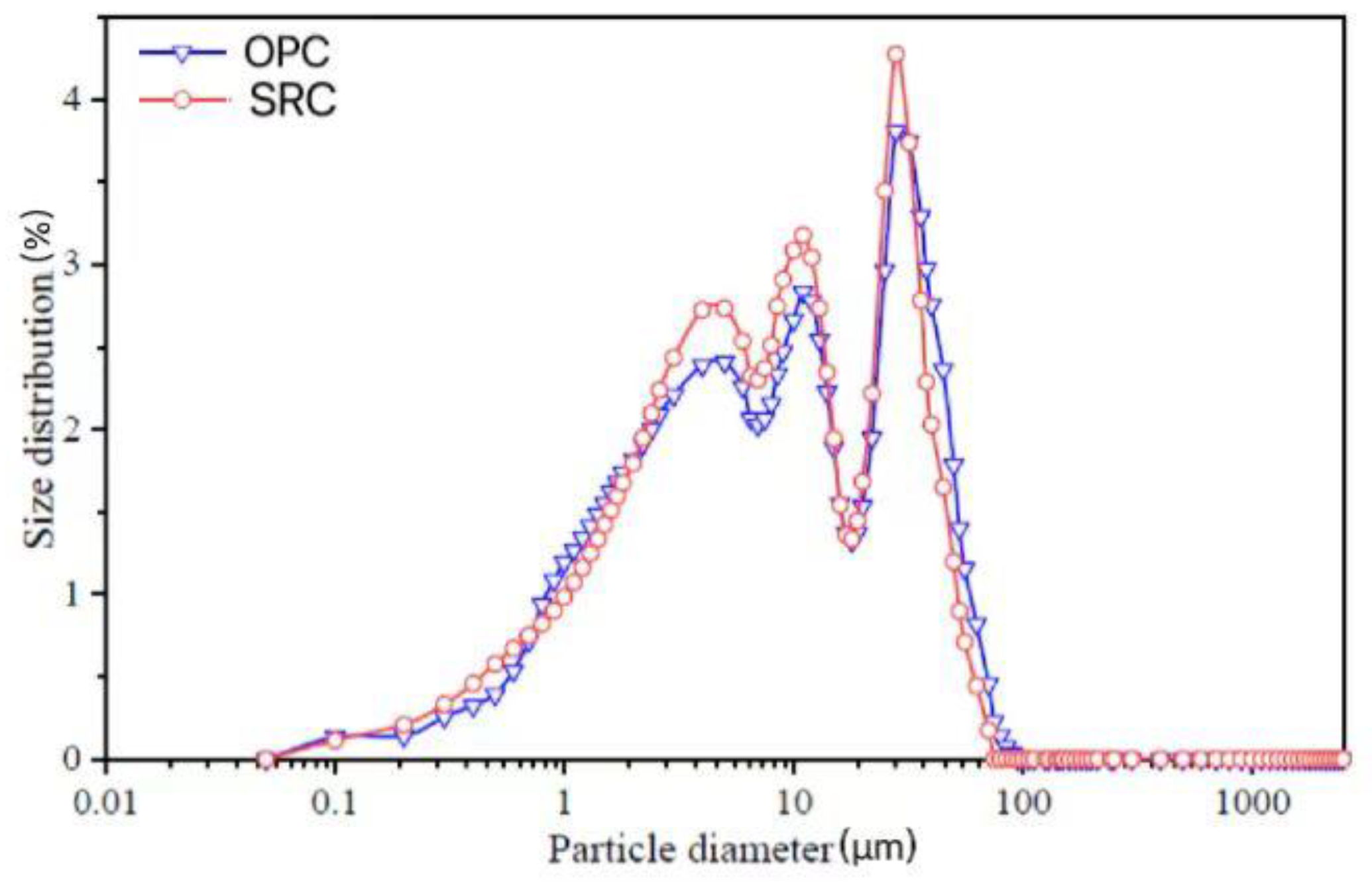
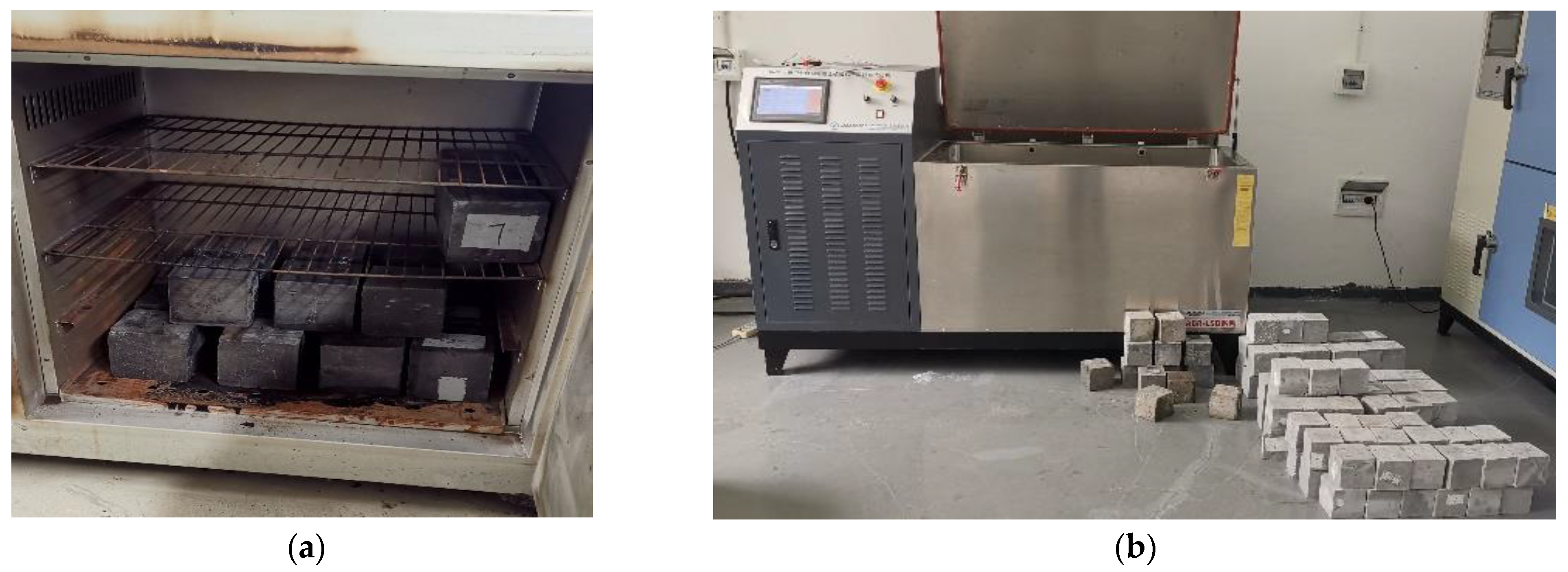

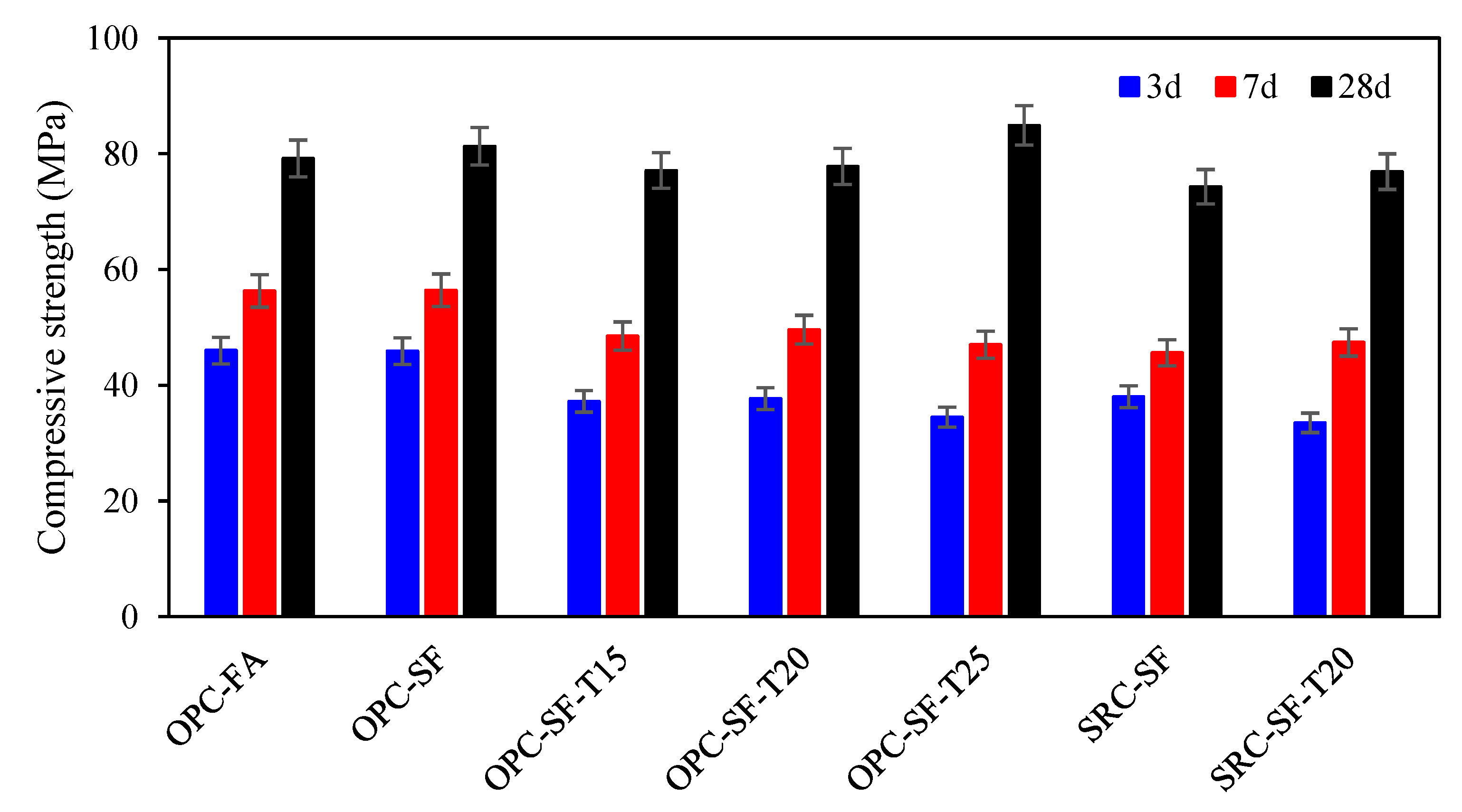

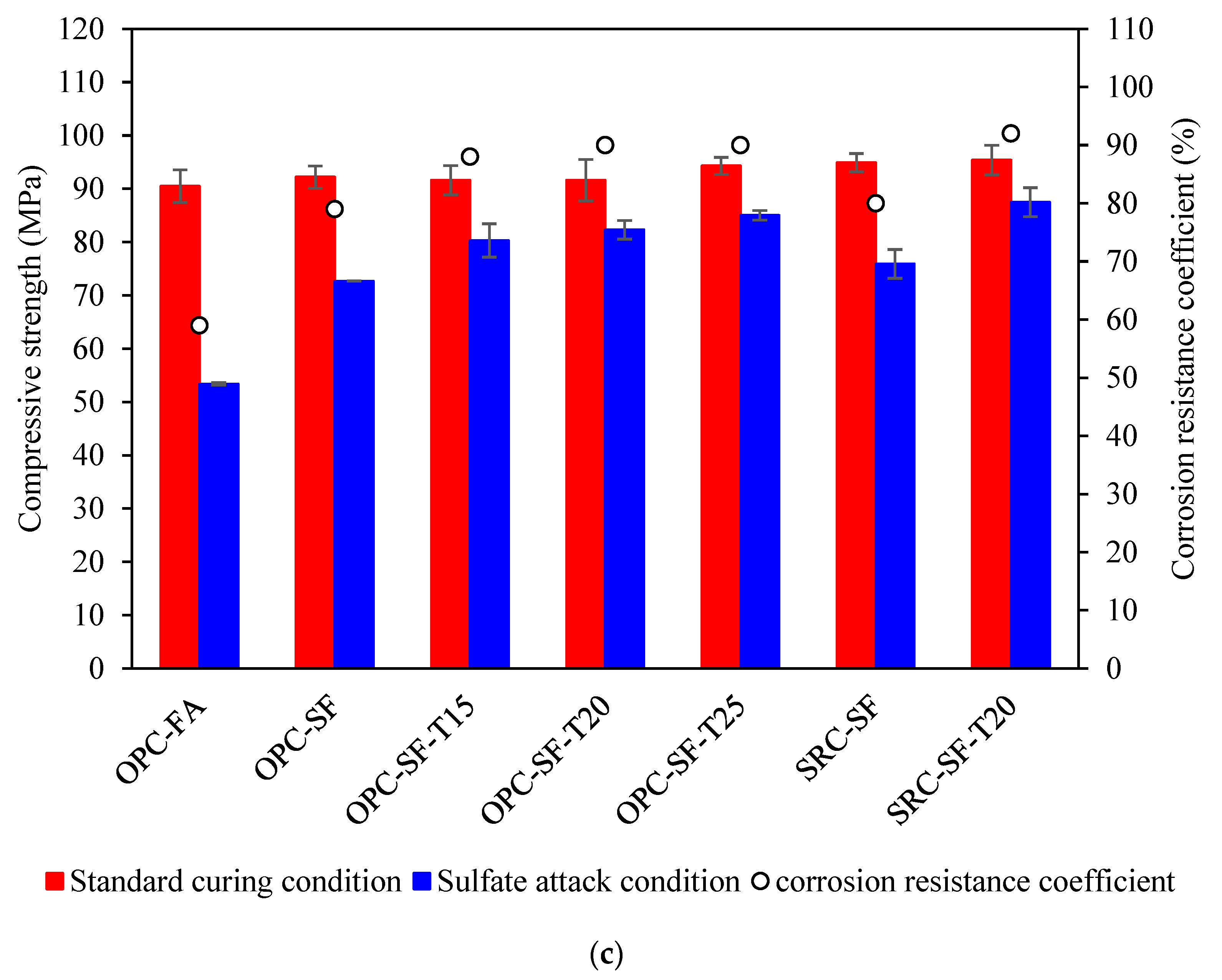
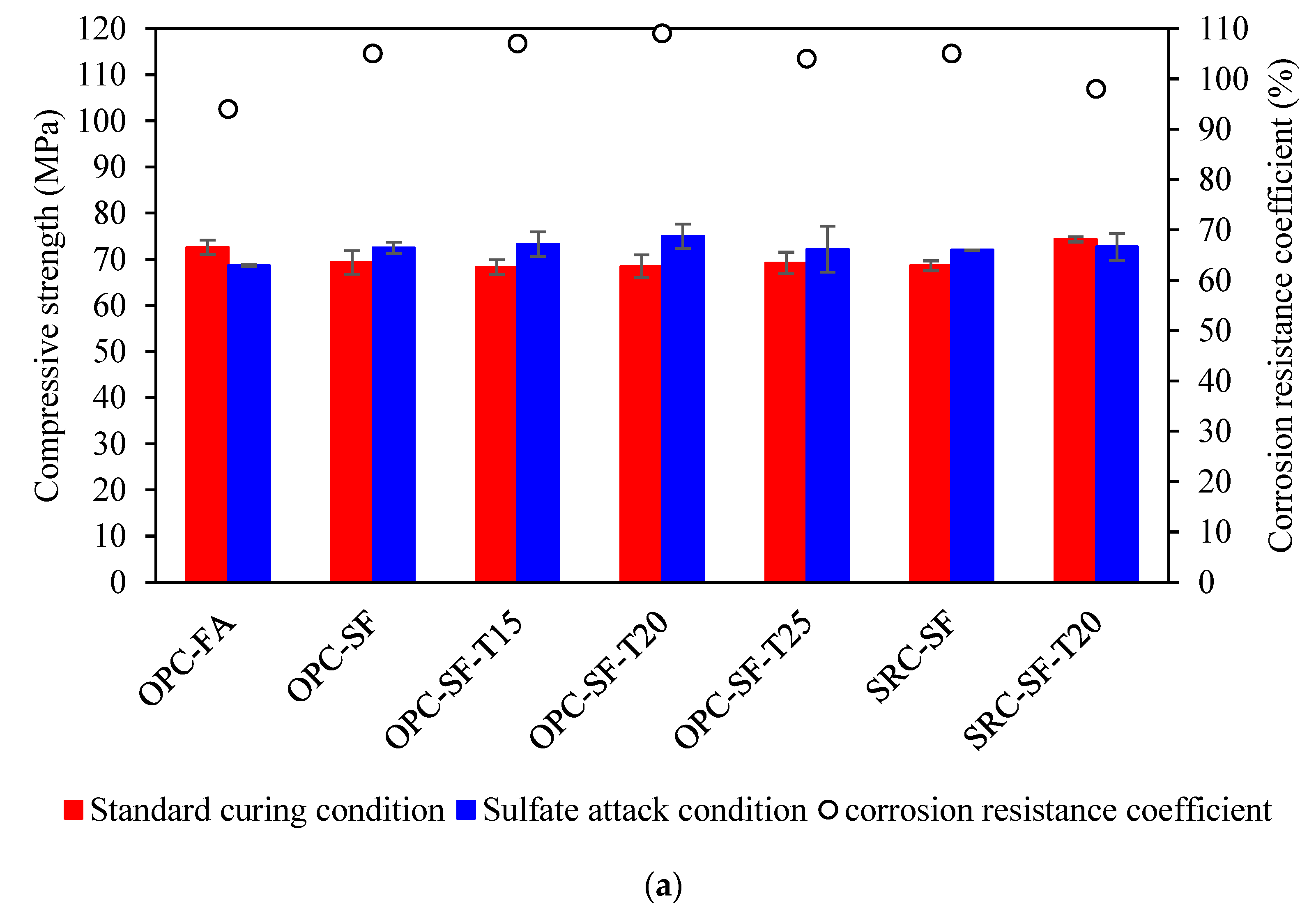


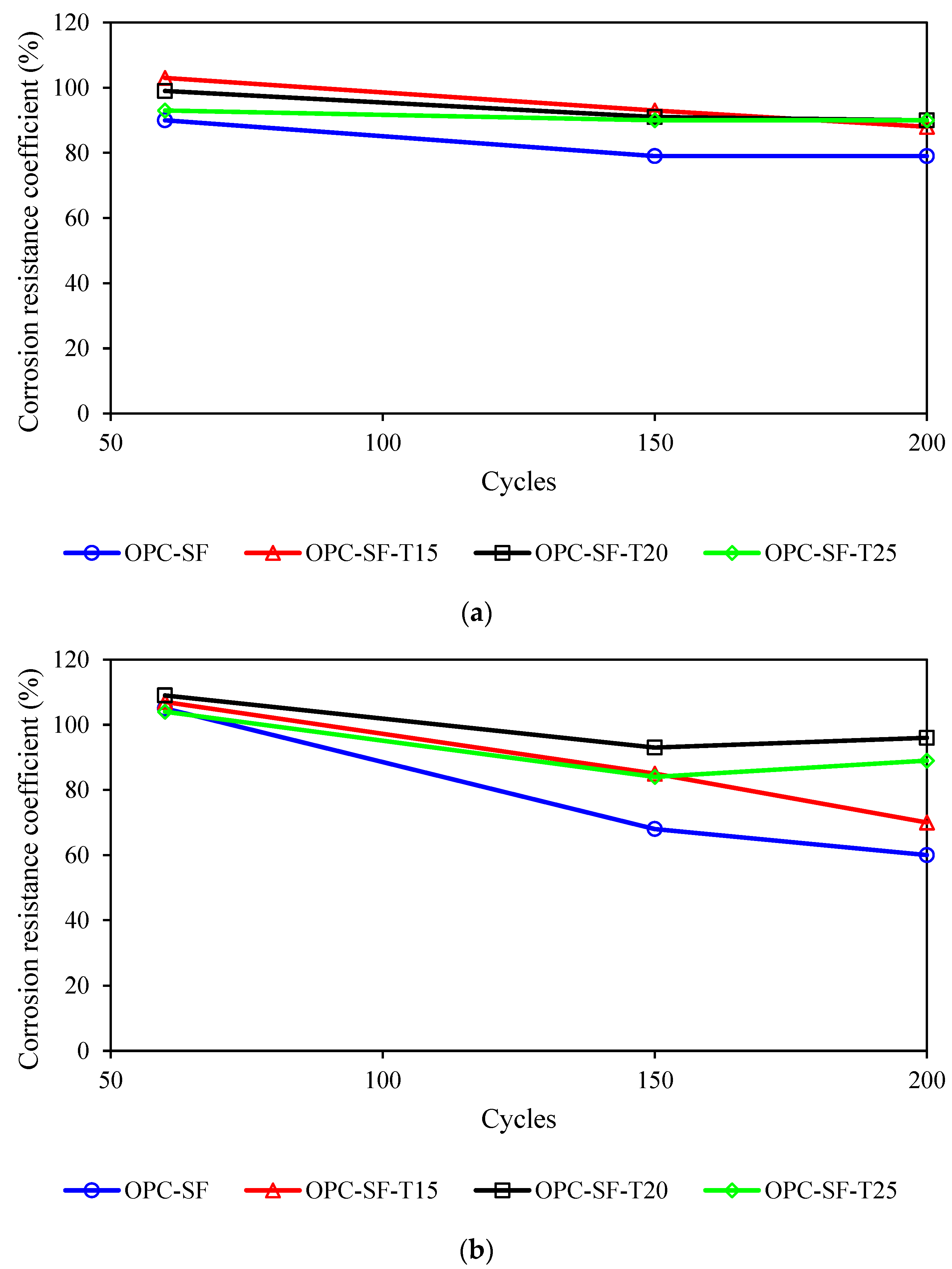

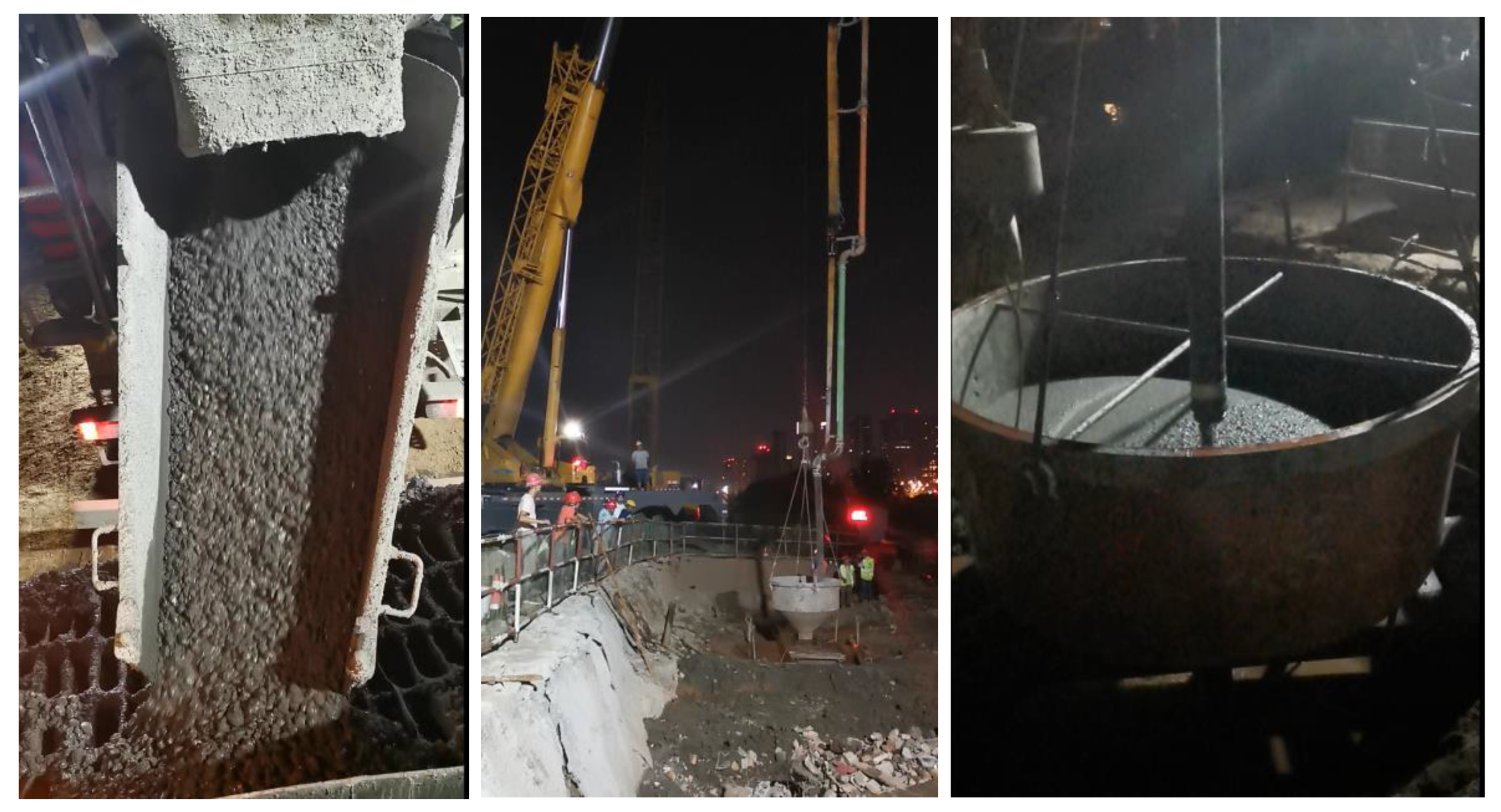
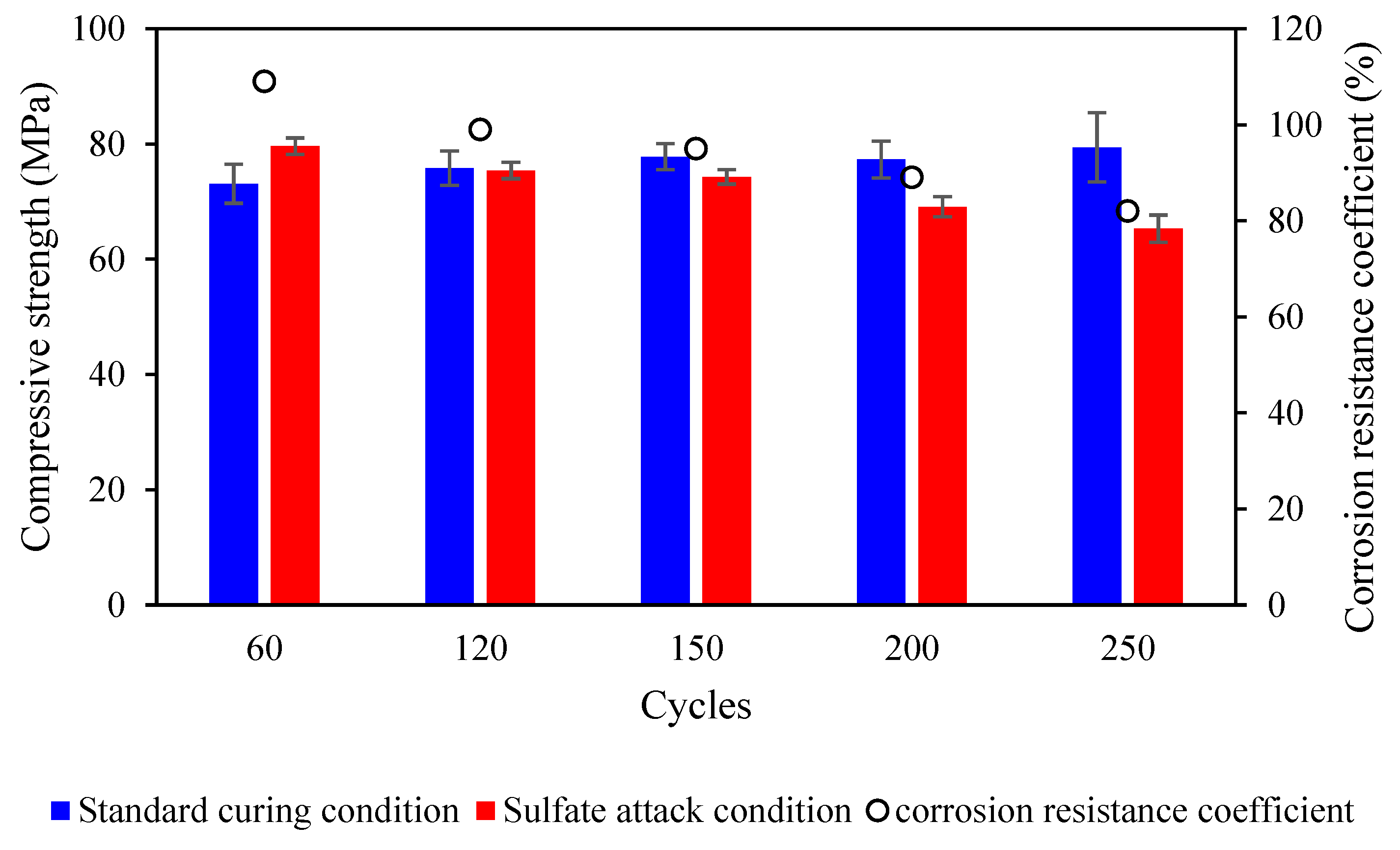
| Chemical Compositions | SRC | OPC | SF | FA |
|---|---|---|---|---|
| SiO2 | 20.41 | 20.31 | 96.08 | 46.59 |
| CaO | 61.91 | 65.50 | 0.21 | 4.98 |
| Al2O3 | 3.55 | 4.80 | 0.84 | 38.52 |
| SO3 | 2.22 | 2.10 | 0.51 | 0.66 |
| Fe2O3 | 3.91 | 4.99 | 0.09 | 3.93 |
| K2O | 0.54 | 0.40 | 0.21 | 0.66 |
| MgO | 2.72 | 1.30 | 0.08 | 0.96 |
| Na2O | 0.91 | 0.15 | 0.21 | 0.20 |
| TiO2 | 0.24 | 0.39 | - | 1.69 |
| No. | ID | OPC | SRC | FA | SF | Fine Aggregate | Coarse Aggregate | Corrosion Inhibitor | Water | WRA |
|---|---|---|---|---|---|---|---|---|---|---|
| 1 | OPC-FA | 360 | 0 | 110 | 0 | 808 | 1062 | 0 | 160 | 1.70% |
| 2 | OPC-SF | 360 | 0 | 80 | 30 | 792 | 1051 | 0 | 160 | 1.60% |
| 3 | OPC-SF-T15 | 360 | 0 | 80 | 30 | 792 | 1051 | 15 | 145 | 1.60% |
| 4 | OPC-SF-T20 | 360 | 0 | 80 | 30 | 792 | 1051 | 20 | 140 | 1.65% |
| 5 | OPC-SF-T25 | 360 | 0 | 80 | 30 | 792 | 1051 | 25 | 140 | 1.65% |
| 6 | SRC-SF | 0 | 360 | 80 | 30 | 792 | 1051 | 0 | 160 | 1.60% |
| 7 | SRC-SF-T20 | 0 | 360 | 80 | 30 | 792 | 1051 | 20 | 140 | 1.65% |
| Slump/mm | Spread/mm | Vebe Time/s | Setting Time/h | Compressive Strength/MPa | ||||||
|---|---|---|---|---|---|---|---|---|---|---|
| 0 | 3 h | 0 | 3 h | 0 | 3 h | Initial setting | Final setting | 3 d | 7 d | 28 d |
| 230 | 215 | 595 | 570 | 8 | 10 | 9.4 | 14.0 | 44.2 | 53.1 | 65.6 |
Disclaimer/Publisher’s Note: The statements, opinions and data contained in all publications are solely those of the individual author(s) and contributor(s) and not of MDPI and/or the editor(s). MDPI and/or the editor(s) disclaim responsibility for any injury to people or property resulting from any ideas, methods, instructions or products referred to in the content. |
© 2024 by the authors. Licensee MDPI, Basel, Switzerland. This article is an open access article distributed under the terms and conditions of the Creative Commons Attribution (CC BY) license (https://creativecommons.org/licenses/by/4.0/).
Share and Cite
Zhang, Y.; Tang, Z.; Liu, X.; Zhou, X.; He, W.; Zhou, X. Study on the Resistance of Concrete to High-Concentration Sulfate Attack: A Case Study in Jinyan Bridge. Materials 2024, 17, 3388. https://doi.org/10.3390/ma17143388
Zhang Y, Tang Z, Liu X, Zhou X, He W, Zhou X. Study on the Resistance of Concrete to High-Concentration Sulfate Attack: A Case Study in Jinyan Bridge. Materials. 2024; 17(14):3388. https://doi.org/10.3390/ma17143388
Chicago/Turabian StyleZhang, Yingda, Zhaopeng Tang, Xinyue Liu, Xianliang Zhou, Wenting He, and Xiaojun Zhou. 2024. "Study on the Resistance of Concrete to High-Concentration Sulfate Attack: A Case Study in Jinyan Bridge" Materials 17, no. 14: 3388. https://doi.org/10.3390/ma17143388





